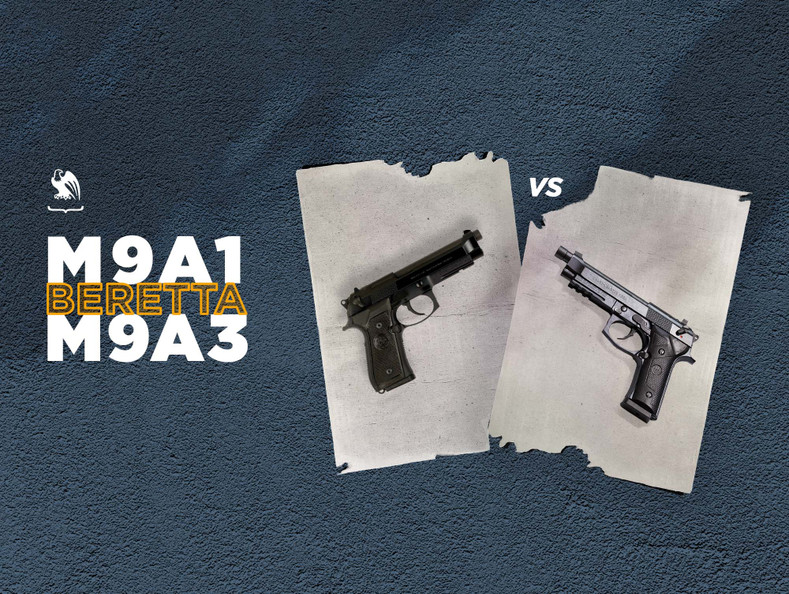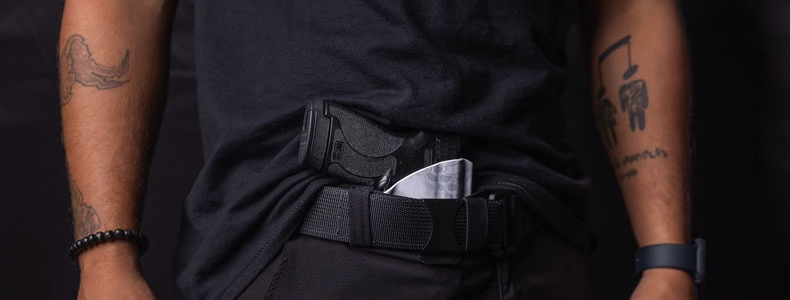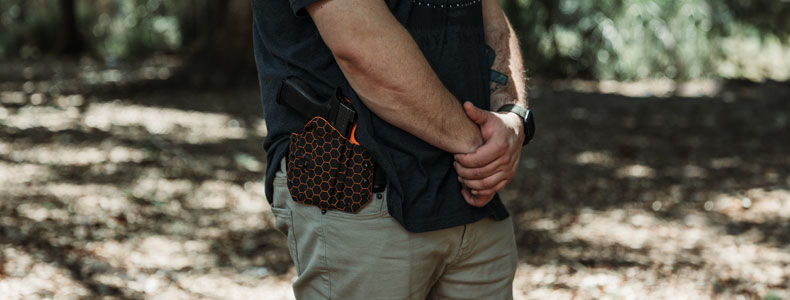Beretta M9A1 vs M9A3: Side by Side Comparison

Very few firearms have been a top choice for military, police, and civilian shooters alike for over half a century like the Beretta M9 series.
Two of the updates of the M9 design, the M9A1, and the M9A3, are still some of the more compelling full-size handguns on the market today. But, what are the differences between these two guns, and which is the best option for you?
While both of these pistols are truly world-class designs and come from the same general blueprint, there might well be some differences between the two that make one better than the other for your purposes.
The Beretta M9A1 vs M9A3 are very similar in terms of specs and overall design. The M9A3 has a higher capacity and is a bit more customizable, with a threaded barrel, longer rail, and removable front sight. The M9A1, on the other hand, has a three-dot sight and a slightly shorter barrel.
In this article, we’ll compare each of these gun models head to head, getting into specifics of size, ergonomics, optics, controls, and more.
Products Mentioned In This Article
Beretta M9A1

For a lot of folks fighting in the Global war on terror, their first encounter with a pistol was a Beretta M9A1. According to Beretta’s website, the M9A1 was designed specifically to meet Marine Corps requirements that were cognizant of not only Desert Storm in 1990-91 but the then-ongoing conflicts in Iraq and Afghanistan.
The main thing that folks transitioning from the M9 to the A1 variant would be likely to notice is the inclusion of a Picatinny rail on the underside of the pistol’s frame. This allows users to attach lights and lasers, greatly enhancing the operational capabilities of the weapon. From there, the changes are more subtle.
The front and back straps, as well as the grips, of the A1 model are more aggressive than its older counterpart to make it easier to grip while sweating or wearing gloves. Additionally, the M9A1 came with magazines with a specially designed coating to resist the sand that is so common in Iraq.
Basically, you can think of the M9A1 as a slightly refreshed and face-lifted model of the M9, with both some cosmetic and performance improvements to make it a more effective weapon for troops in the field.
If you’re looking for a Kydex or hybrid Beretta M9A1 holster, check out our selection of IWB and OWB holsters here.
Beretta M9A3

If the A1 model was a refreshed version of the M9, the A3 variant is something like what folks in the car community might call a restomod: a redesign and retrofitting that keeps the original design philosophy in mind, but that stretches performance to its limits.
The A1 model was adopted into military service in 2006. With about another decade of learning in the field, arguably the best research and development on the planet, Beretta came out with the A3 in 2015.
The M9A3 adds even more Picatinny rail to give users more options for installing lights and lasers, in addition to larger, 17-round magazines. The grip was also thinned out, with the option to add a more traditional, thicker grip. Finally, the magazine geometry was changed to make it easier to reload by feel.
In effect, the M9A3’s list of changes represents a fine-tuning of the M9A1 into one of the most compelling military pistols that are in current or recent use.
If you’re looking for a Kydex or hybrid M9A3 holster, check out our selection of IWB and OWB holsters here.
Beretta M9A1 vs M9A3: Specs
Beretta M9A1 vs M9A3: Size & Capacity
With most of these comparisons, we’re going to be splitting hairs, since both the A1 and A3 are iterations of the M9 design. There are, however, some meaningful differences when it comes to size and capacity.
As you can see in the chart above, the two pistols are very similar in size, with an inch here and an ounce there being added and subtracted in the various dimensions of the two designs.
Importantly, the M9A3’s standard magazine capacity is 17 rounds, two more than the older design. Those two rounds in effectively the same sized pistol lead us to lean a little bit in the direction of the M9A3 in this category.

Beretta M9A1 vs M9A3: Ergonomics
Frame
The major difference in the frames between these two firearms is that the M9A3 has a slightly more vertical hand position than the M9A1. For folks picking up both of them for the first time on the same day, the A3 might feel a little more natural to point and shoot. If, on the other hand, people spent many range days with the A1, then the older model will likely feel more like home.
The difference in frame geometry is also somewhat offset given that the A3 can be used with a thicker grip that is the same size as that of the A1 as well as its standard, very slightly thinner grip profile.
Slide & Barrel
Here is where things get a little bit different: while the slide on the two guns is extremely similar, the two major upgrades on the A3 model give it the edge here.
First, the A3’s slide can be switched between models with or without a decocker. While this is a niche feature, it’s one that some folks will deeply appreciate, considering you can have a new slide shipped to your door.
Second, the A3’s barrel comes threaded from the factory, making the A3 a better choice for people who might be thinking about suppressing their M9s.
Generally, the A1 and A3 shoot very similarly in terms of their slide and barrel, but the ability to more easily suppress the A3 with the included threaded barrel might sway some folks. Oh, also, the M9A3 comes in Flat Dark Earth in case you want your M9 in a color other than black.

Beretta M9A1 vs M9A3: Sights & Optics
This might be the category in which these firearms differ most from each other, and where a lot of users might make their choice between them a little clearer.
The M9A1 comes with white three-dot sights that are relatively easy to use in the daytime, and reasonably well at night.
The rear sights are adjustable on the A1 model, meaning you can drift them left to right to zero the pistol, or replace them entirely with a mode of your choice from the aftermarket. But, and this is important, the front sights are integral and are not coming off without a grinder.So, if you like a white dot front sight, good. If not, then you might like the A3.
The A3 model was designed so both the rear and front sights are removable. This opens users up to a lot more options, including raised sights for use with suppressors, making the threaded barrel that much more useful.
You can attach a light or laser on the bottom of the frame of both the A1 and the A3. The A3 does have a longer Picatinny rail in addition to being able to swap out the front sight, which the A1 cannot do.
Beretta M9A1 vs M9A3: Controls
Safety
In their stock configurations, both the M9A1 and M9A3 have a combination decocker and safety, which makes it possible for these guns to be carried with the hammer down on a live chamber safely.
Here the edge goes to the M9A3 since it is possible to buy a slide that only has a decocker. Many folks consider the additional manual safety to be redundant and unnecessary. There are ways to do the same thing to an A1, but it’s a lot more involved than simply popping on a new slide like you can with the A3.
Trigger
The trigger on these two firearms is identical for the purposes of most shooters: it’s a double/single-action trigger that takes some getting used to.
With DA/SA triggers, the first pull is a heavy one that cocks the hammer and then fires a round, while subsequent shots are lighter and shorter. This means that the shooter will have to get used to two different trigger pulls to shoot either of these handguns well.

Which is Right For Me?
Because the A1 and A3 models of the M9 are so similar to each other, the choice here will be a mostly personal one depending on your preference.
If you’d like to get the most modern version of the M9, with the ability to easily use a suppressor and upgraded sights along with larger lights and lasers, then the M9A3 is for you.
The Beretta M9A3’s accuracy might be a little bit better than its older predecessor with some upgraded sights, better grips, and more optics options on the bottom of the frame. And if the accuracy doesn’t help, then you get two more rounds to hit the target.
With that said, one thing to seriously consider is the possibility of getting an awesome deal. Since the M9A1 is no longer in production, you can often buy them for less, and they make great concealed-carry guns. The Beretta M9A1 specs are certainly nothing to scoff at, and it’s an excellent defensive tool.
Summary

The variations between the Beretta M9A1 vs M9A3 are very small. The two pistols are very similar in size, with the main differences being in their sights and slides.
Overall, both of these make an excellent choice of full-size handgun, and either one would serve you well: if you want the most modern version go for the A3 model, but an A1 at a deep discount in the local gun store would be an almost ideal gun for people who plan to shoot a lot and want good quality for the money.
If you’re looking for a new IWB, OWB, or pocket carry holster, visit our Holsters by Gun Model page for Kydex holsters that are custom-made for your weapon of choice.
Interested in items beyond holsters? Check out our Resources Page for links to recommended products like lights, lasers, first aid, maintenance, and more, and browse our selection of belts, apparel, and accessories at our website, vedderholsters.com.
To stay up-to-date on all the latest Vedder Holsters content and offerings, check out our blog and follow us on Facebook, Instagram, and Twitter. And be sure to visit our sister company, GeoGrit, for all of your American-made minimalist wallet needs.



